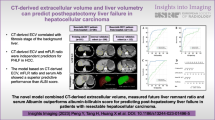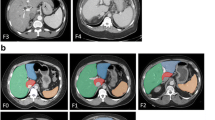Abstract
Objectives
To compare the predictive ability of liver fibrosis (LF) by CT-volumetry (CTV) for liver and spleen and extracellular volume fraction (ECV) for liver in patients undergoing liver resection.
Methods
We retrospectively analysed 90 consecutive patients who underwent CTV and ECV. Manually placed region-of-interest ECV (manual-ECV), rigid-registration ECV (rigid-ECV), and nonrigid-registration ECV (nonrigid-ECV) were calculated as ECV(%) = (1-haematocrit) × (ΔHUliver/ΔHUaorta), where ΔHU = subtraction of unenhanced phase from equilibrium phase (240 s). Manual-ECV was compared with CTV for the estimation of LF. The total liver volume to body surface area (TLV/BSA), splenic volume to BSA (SV/BSA), ratio of TLV to SV (TLV/SV), ratio of right liver volume to SV (RV/SV), and liver segmental volume ratio (LSVR) were measured. ROC analyses were performed for ECV and CTV.
Results
After excluding 10 patients, seventy-eight (97.5%) out of 80 patients had a Child-Pugh score of 5 points, and two (2.5%) patients had a Child-Pugh score of 6 points. AUC of ECV showed no significant difference among manual-ECV, rigid-ECV, and nonrigid-ECV. TLV/BSA, SV/BSA, TLV/SV, and RV/SV had a higher correlation with LF grades than manual-ECV. AUC of SV/BSA was significantly higher than that of manual-ECV in F0-1 vs F2-4 and F0-2 vs F3-4. AUC of SV/BSA (0.76–0.83) was higher than that of manual-ECV (0.61–0.75) for all LF grades, although manual-ECV could differentiate between F0-3 and F4 at high AUC (0.75).
Conclusions
In patients undergoing liver resection, SV/BSA is a better method for estimating severe LF grades, although manual-ECV has the ability to estimate cirrhosis (≥ F4).
Key Points
-
The splenic volume is a better method for estimating liver fibrosis grades.
-
The extracellular volume fraction is also a candidate for the estimation of severe liver fibrosis.





Similar content being viewed by others
Abbreviations
- APRI:
-
Aspartate aminotransferase-platelet ratio index
- BSA:
-
Body surface area
- Cr:
-
Creatinine
- CTV:
-
Computerised tomography volumetry
- ECV:
-
Extracellular volume fraction
- FIB-4:
-
Fibrosis index based on the four factors
- Hct:
-
Haematocrit
- ICGR15:
-
Indocyanine green retention rates at 15 minutes after injection
- INR:
-
International normalised ratio
- LF:
-
Liver fibrosis
- LSVR:
-
Liver segmental volume ratio, which is volume ratio of Couinaud segments I-III to segmnts IV-VIII
- manual-ECV:
-
ECV by manually placed region-of-interests
- nonrigid-ECV:
-
Nonrigid registration ECV
- Plt:
-
Platelet count
- rigid-ECV:
-
Rigid registration ECV
- RV/SV:
-
Ratio of RV to SV
- RV:
-
Right liver volume
- SV:
-
Splenic volume
- TLV/SV:
-
Ratio of TLV to SV
- TLV:
-
Total liver volume
References
Belghiti J, Hiramatsu K, Benoist S, Massault P, Sauvanet A, Farges O (2000) Seven hundred forty-seven hepatectomies in the 1990s: an update to evaluate the actual risk of liver resection. J Am Coll Surg 191:38–46
Fan ST, Lai EC, Lo CM, Ng IO, Wong J (1995) Hospital mortality of major hepatectomy for hepatocellular carcinoma associated with cirrhosis. Arch Surg 130:198–203
Regev A, Berho M, Jeffers LJ et al (2002) Sampling error and intraobserver variation in liver biopsy in patients with chronic HCV infection. Am J Gastroenterol 97:2614–2618
Gilmore IT, Burroughs A, Murray-Lyon IM, Williams R, Jenkins D, Hopkins A (1995) Indications, methods, and outcomes of percutaneous liver biopsy in England and Wales: an audit by the British Society of Gastroenterology and the Royal College of Physicians of London. Gut 36:437–441
Pickhardt PJ, Malecki K, Hunt OF et al (2017) Hepatosplenic volumetric assessment at MDCT for staging liver fibrosis. Eur Radiol 27:3060–3068
Tarao K, Hoshino H, Motohashi I et al (1989) Changes in liver and spleen volume in alcoholic liver fibrosis of man. Hepatology 9:589–593
Shinagawa Y, Sakamoto K, Sato K, Ito E, Urakawa H, Yoshimitsu K (2018) Usefulness of new subtraction algorithm in estimating degree of liver fibrosis by calculating extracellular volume fraction obtained from routine liver CT protocol equilibrium phase data: preliminary experience. Eur J Radiol 103:99–104
Yoon JH, Lee JM, Klotz E et al (2015) Estimation of hepatic extracellular volume fraction using multiphasic liver computed tomography for hepatic fibrosis grading. Invest Radiol 50:290–296
Varenika V, Fu Y, Maher JJ et al (2013) Hepatic fibrosis: evaluation with semiquantitative contrast-enhanced CT. Radiology 266:151–158
Liu P, Li P, He W, Zhao LQ (2009) Liver and spleen volume variations in patients with hepatic fibrosis. World J Gastroenterol 15:3298–3302
Bae JS, Lee DH, Yoo J et al (2021) Association between spleen volume and the post-hepatectomy liver failure and overall survival of patients with hepatocellular carcinoma after resection. Eur Radiol 31:2461–2471
Lotan E, Raskin SP, Amitai MM et al (2017) The role of liver segment-to-spleen volume ratio in the staging of hepatic fibrosis in patients with hepatitis C virus infection. Isr Med Assoc J 19:251–256
Furusato Hunt OM, Lubner MG, Ziemlewicz TJ, Muñoz Del Rio A, Pickhardt PJ (2016) The liver segmental volume ratio for noninvasive detection of cirrhosis: comparison with established linear and volumetric measures. J Comput Assist Tomogr 40:478–484
Obmann VC, Marx C, Hrycyk J et al (2020) Liver segmental volume and attenuation ratio (LSVAR) on portal venous CT scans improves the detection of clinically significant liver fibrosis compared to liver segmental volume ratio (LSVR). Abdom Radiol (NY) 46:1912–1921
Wai CT, Greenson JK, Fontana RJ et al (2003) A simple noninvasive index can predict both significant fibrosis and cirrhosis in patients with chronic hepatitis C. Hepatology 38:518–526
Vallet-Pichard A, Mallet V, Nalpas B et al (2007) FIB-4: an inexpensive and accurate marker of fibrosis in HCV infection. Comparison with liver biopsy and fibrotest. Hepatology 46:32–36
Kamath PS, Wiesner RH, Malinchoc M et al (2001) A model to predict survival in patients with end-stage liver disease. Hepatology 33:464–470
Okada M, Kondo H, Sou H et al (2013) The efficacy of contrast protocol in hepatic dynamic computed tomography: multicenter prospective study in community hospitals. Springerplus 2:367
Lubner MG, Pooler BD, del Rio AM, Durkee B, Pickhart PJ (2014) Volumetric evaluation of hepatic tumors: multi-vendor, multi-reader liver phantom study. Abdom Imaging 39:488–496
Bandula S, Punwani S, Rosenberg WM et al (2015) Equilibrium contrast-enhanced CT imaging to evaluate hepatic fibrosis: initial validation by comparison with histopathologic sampling. Radiology 275:136–143
Piper J, Ikeda Y, Fujisawa Y et al (2012) Objective evaluation of the correction by non-rigid registration of abdominal organ motion in low-dose 4-D dynamic contrast-enhanced CT. Phys Med Biol 57:1701–1715
Chandler A, Wei W, Anderson EF, Herron DH, Ye Z, Ng CS (2012) Validation of motion correction techniques for liver CT perfusion studies. Br J Radiol 85(1016):e514–e522
Vercauteren T, Pennec X, Perchant A, Ayache N (2009) Diffeomorphic demons: efficient non-parametric image registration. Neuroimage 45(Suppl):S61–S72
Mattes D, Haynor D, Vesselle H, Lewellyn T, Eubank W (2001) Nonrigid multimodality image registration. J Med Imaging SPIE:4322
Chow KU, Luxembourg B, Seifriend E, Bonig H (2016) Spleen size is significantly influenced by body height and sex: establishment of Normal values for spleen size at US with a cohort of 1200 healthy individuals. Radiology 279:306–313
DeLand FH (1970) Normal spleen size. Radiology 97:589–592
Du Bois D, Du Bois EF (1916) A formula to estimate the approximate surface area if height and weight be known. Nutrition, 1989 5:303–311 discussion 312–313
Ichida F, Tsuji T, Omata M et al (1996) New Inuyama classification; new criteria for histological assessment of chronic hepatitis. Int Hepatol Commun 6:112–119
Bolognesi M, Merkel C, Sacerdoti D, Nava V, Gatta A (2002) Role of spleen enlargement in cirrhosis with portal hypertension. Dig Liver Dis 34:144–150
Horowitz JM, Venkatesh SK, Ehman RL et al (2017) Evaluation of hepatic fibrosis: a review from the society of abdominal radiology disease focus panel. Abdom Radiol (NY) 42:2037–2053
Acknowledgements
The authors would like to acknowledge all of the patients for their willingness to participate in the study.
Funding
The authors state that this work has not received any funding.
Author information
Authors and Affiliations
Corresponding author
Ethics declarations
Guarantor
The scientific guarantor of this publication is Masahiro Okada.
Ethical approval
Institutional Review Board approval was obtained.
Statistics and biometry
No complex statistical methods were necessary for this paper.
Informed consent
Written informed consent was not required for this study because of the retrospective nature of this study.
Conflict of interest
The authors of this manuscript declare no relationships with any companies whose products or services may be related to the subject matter of the article.
Methodology
• retrospective
• observational
• performed at one institution
Additional information
Publisher’s note
Springer Nature remains neutral with regard to jurisdictional claims in published maps and institutional affiliations.
Rights and permissions
About this article
Cite this article
Tago, K., Tsukada, J., Sudo, N. et al. Comparison between CT volumetry and extracellular volume fraction using liver dynamic CT for the predictive ability of liver fibrosis in patients with hepatocellular carcinoma. Eur Radiol 32, 7555–7565 (2022). https://doi.org/10.1007/s00330-022-08852-x
Received:
Revised:
Accepted:
Published:
Issue Date:
DOI: https://doi.org/10.1007/s00330-022-08852-x




